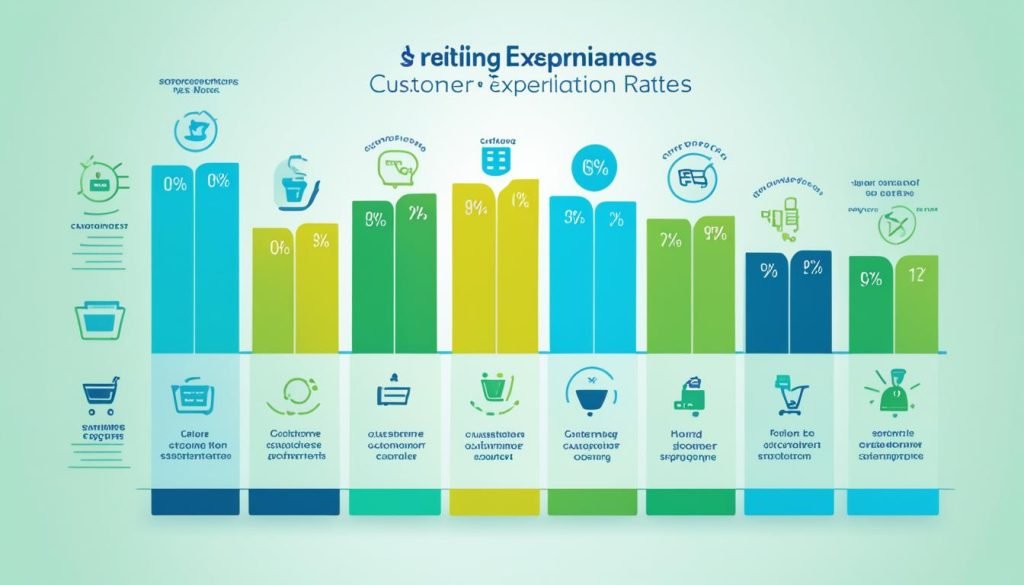The retail customer experience is very important in today’s market. When a customer has a great shopping experience, they’re more likely to come back. They also tell their friends about the good service they received. This is especially true now, when online and in-person stores are coming together. Making sure the shopper’s journey is smooth and pleasant no matter where they start is key.
We will look into how to make shopping in a store more fun. Plus, we’ll see how technology can make shopping feel tailor-made, encouraging shoppers to return.
Key Takeaways:
- Creating a good shopping memory is vital for shops to do well.
- Making stores inviting and having helpful employees increases how much people enjoy their visit and how often they come back.
- Customizing online shopping makes it more special for each person.
- It’s important to track things like how happy customers are and the effect on sales. This info helps shops get better in smart ways.
- Focusing on making customers happy can really help a business grow and keep customers coming back.
Enhancing the In-Store Journey
The in-store journey is vital for a great customer experience. Retailers can make it better by focusing on making the store look appealing, adding interactive features, offering personalized service, and having friendly staff.
Store Layout Optimization
A good store design catches the eye and makes a great first impression. It should reflect the brand’s identity to connect with customers. The entrance must be attractive to welcome customers inside.
A clear layout helps customers navigate easily. This makes it simple to find what they want, improving their experience. Displaying products well creates a sense of value, making customers more likely to buy.
Interactive Elements
Adding interactive tech can make the store experience fun and engaging. Digital screens can show off products and provide useful information. VR and AR allow customers to interact with products in interesting ways.
Smart fitting rooms with advanced tech offer personalized help. This recommends items and makes shopping easy. These interactive features leave a good memory and encourage repeat visits.
Personalized Customer Service and Engaging Staff
Personalized service makes a big difference. When staff suggests things based on what customers like, it shows they care. Helping customers find exactly what they need builds trust.
“The staff at BrandX Store was incredibly knowledgeable and friendly. They went above and beyond to provide personalized advice and product recommendations. It made my shopping experience truly enjoyable!” – Satisfied Customer
Training your team well is key to keeping customers happy. Staff that knows their stuff can help customers. This makes the store a friendly place where people want to shop more.
By optimizing the layout, adding tech, offering tailored service, and having great staff, retailers can make the store experience unforgettable. This leads to happier customers, more loyalty, and better business success.
Personalization in the Digital Retail Experience
In today’s world, online shopping is just as vital as visiting a physical store. It’s all about making the digital space personal. This makes customers feel special and understood. Retailers use special online shopping features, combine them with the real-life store, and add fun content. This way, each shop is made just for you.
AI-powered recommendations are a game-changer. They look at what you like and suggest suitable products. This makes shopping easier and more fun. You’re more likely to spot something you really love.
Ever tried on clothes online? With AR, now you can. It lets you see how clothes, accessories, or furniture would look in your space. This makes choosing items more exciting and helps you shop smartly.
Adding things you can play with online, like custom design tools, also makes a big difference. For instance, imagine picking the color of your new sofa. It turns shopping into a creative and personal experience. You get to design your own stuff.
A website that’s easy to use and looks great is a must. It should be simple to find and buy what you want. This way, shopping becomes smooth and enjoyable. Good websites keep you coming back for more.
Personal touches really make your digital shopping stand out. Whether it’s through clever suggestions, trying on products virtually, designing your own, or a nice website. All these features come together to make shopping your favorite spot. This keeps you happy and coming back again.
Benefits of Personalization in the Digital Retail Experience
- Enhanced customer satisfaction and loyalty
- Higher conversion rates and sales
- Increased customer engagement and interaction
- Improved brand perception and differentiation
- More accurate and targeted product recommendations
Metrics for Measuring Retail Customer Experience
Understanding the success of customer experience strategies is crucial. Retailers can use loyalty programs, data analytics, and customer feedback to learn more. These methods help figure out how satisfied and loyal customers are. They also show how personalized experiences affect revenue.
Loyalty programs are key for seeing how engaged and loyal customers are. Retailers can tell how well their programs are doing by looking at who joins, how much they buy, and at what cost. Data analytics are also important. They help understand what customers like by looking at metrics on spending and groups of buyers. This information guides smart decisions that make the shopping experience better.
Customer feedback is very telling too. Reviews, surveys, and social media can show a store’s overall customer service. By listening and reacting to feedback, stores can make shoppers happier. This, in turn, makes customers more likely to come back.
Of course, what really matters for businesses is the money their efforts bring in. By checking how many visitors actually buy something, how much they spend, and the total sales increase, stores can see if their efforts pay off. This helps them know if they should keep investing in making customers’ shopping experiences better.
A Comprehensive Table of Customer Experience Metrics:
| Metric | Definition | Value |
|---|---|---|
| Customer Retention Rate | The percentage of customers who continue to make purchases over a specific period. | 85% |
| Sales-Conversion Rate | The percentage of visitors who make a purchase. | 5% |
| Revenue Lift | The increase in revenue generated as a result of customer experience initiatives. | $500,000 |
| Average Order Value | The average monetary value of each customer’s order. | $100 |
| Customer Satisfaction Score | A metric that measures customer satisfaction levels based on surveys or feedback. | 8.5/10 |
It’s vital for retailers to track these metrics closely. This shows how well their efforts are working. It opens up chances for them to get better and grow their business through happier, more loyal customers.

Conclusion
Creating a great retail customer experience is crucial for long-term success in retail. It helps build customer loyalty and encourages people to come back. Good experiences make customers share positive recommendations, which can help a store’s reputation and grow its customer base.
To improve customer experiences, it’s key to focus on the journey in the store and use technology well. A store should be well-designed and have staff who are friendly and knowledgeable. Features like digital displays and smart fitting rooms can make a shop visit memorable. Also, it’s important for the online part of a store to offer personalized shopping and easy website design.
Keeping track of how well these efforts work is vital for getting better over time. Things like loyalty programs, measuring data, and listening to customer feedback are important. They tell a store how satisfied and loyal customers are. By looking at numbers like how many customers return, sales, and the money made from these efforts, stores can see if their strategies are working. This allows them to improve based on real information.
As the world of retail changes, focusing on the customer’s experience will remain important. It’s all about creating strong connections, encouraging loyalty, and improving how the whole customer experience feels. This approach helps stores stay ahead and do well in the ever-changing world of retail.





